Striking early 20th-century color photographs from the African colonies of the German Empire
In the summer of 2014, I worked on a library cataloging and itemization project at the National Museum of African Art in the Warren M. Robbins Library. This museum has a wonderful ambiance—even during the high summer with its heat waves and crowds. African Art’s three subterranean levels under the Enid Haupt Garden provide a tranquil retreat with outstanding artwork and an oasis-like central fountain.
Among the many gems I encountered in the library stacks, a rich collection of historic books from the German colonies in Africa caught my attention. Many of these books were beautifully designed and clearly intended to engage the German public with rich illustrative detail of their colonial presence many thousands of miles away.
The German Empire maintained colonies in Africa from 1884 to 1919, consisting of large territorial blocks in West, South and East Africa. These colonies were seized by the Allies as a part of World War I reparations. Ultimately, Germany’s colonial ambitions in Africa had damaging consequences: while the Germans managed to establish some trappings of European existence—railroads, schools, government buildings, etc. —exploitative policies left a negative collective memory on their former subjects. In Germany itself, the loss of the African colonies after WWI was humiliating and viewed by some as a national disaster. Their reclamation was an obsession that drove certain factions of the Nazi Party.
Despite the tense historical context that produced them, some of the following photographs stand out because they present vivid and beautiful depictions of African natural scenery and local customs. Their quality is high enough to imagine oneself standing where the photographer was, gazing at Mt. Kilimanjaro through the rainforest or admiring vibrant African attire. Other photographs provide a glimpse into sinister events of 20th-century history. In both cases, the images provide vital historical documentation.
One of the source books for this article has been digitized and is available through our Digital Library. Janet Stanley, librarian at African Art, can point you to many helpful resources if you’re interested in viewing more photographs from this era. I hope you find these pictures interesting and have a chance to visit the African Art Library in person!
Illustrated book covers about the German colonies

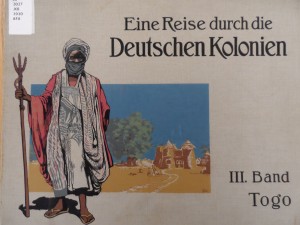
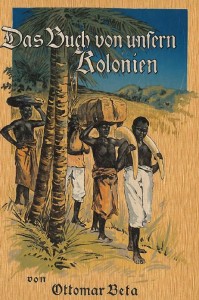
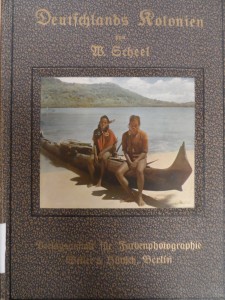
Color photographs from around the German colonies
![The Fruit Market—The golden yellow of fresh oranges looks wonderful along with the rich tones of the colorful garments. [Tanzania]](https://blog.library.si.edu/wp-content/uploads/2015/02/5.obstmarkt-227x300.jpg)
![Young girls from Lome [Togo].](https://blog.library.si.edu/wp-content/uploads/2015/02/1.junge_madchen-244x300.jpg)
![Grasslands in Mbeya [Tanzania]. A wonderful bouquet of colors, the Nyakusa man towers high.](https://blog.library.si.edu/wp-content/uploads/2015/02/5.grasland_bei_mbeya-300x219.jpg)
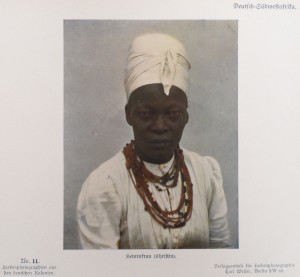
![Perpetual snow on the peak of Kibo. [Kibo is one of three volcanic peaks of Mt. Kilimanjaro in Tanzania].](https://blog.library.si.edu/wp-content/uploads/2015/02/5.ewiger_schnee-300x216.jpg)
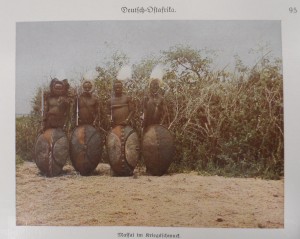
![Flag procession for the German regional gymnastics festival in Luderitzbucht [Namibia] 1939.](https://blog.library.si.edu/wp-content/uploads/2015/02/5.fahneneinmarsch-300x219.jpg)
![Coffee picker on a German plantation. The “mtoto” (child) sleeps unconcerned on the back of his mother. [Tanzania]](https://blog.library.si.edu/wp-content/uploads/2015/02/5.kaffe_pflanzung-272x300.jpg)
![The darkness of the night ascends. Waterberg [South Africa] glows red in the last daylight.](https://blog.library.si.edu/wp-content/uploads/2015/02/5.waterberg_rot_gluht-300x221.jpg)
Bibliography
1) Gann, L., & Duignan, P. (1977). The Rulers of German Africa, 1884—1914. Stanford, CA: Stanford University Press.
2) Stoecker, H. (Ed.). (1986). German Imperialism in Africa: From the Beginnings until the Second World War. London: C. Hurst; Atlantic Highlands, NJ: Humanities Press International.
3) Scheel, W. (1914). Deutschlands Kolonien in achtzig farbenphotographischen Abbildungen : Nach eigenen Naturaufnahmen (2. Aufl.). Berlin: C. Weller.
4) Blenck, H., & Blenck, E. (1914). Afrika in Farben, das Farbbild—Buch der deutschen Kolonien Deutsch—Ost—und—Südwestafrika. Munich: Wustrow.
5) Scheel, W. (1913). Farbenphotographien aus den deutschen Kolonien. Berlin: Verlagsanstalt für Farbenphotographie Carl Weller.


One Comment
Mike these books are beautiful. Thank you for sharing.